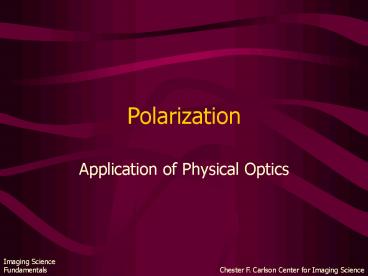Polarization - PowerPoint PPT Presentation
1 / 14
Title:
Polarization
Description:
Light is an electromagnetic wave because it requires two ... MATTE surfaces. Imaging Science Fundamentals. Chester F. Carlson Center for Imaging Science ... – PowerPoint PPT presentation
Number of Views:22
Avg rating:3.0/5.0
Title: Polarization
1
Polarization
- Application of Physical Optics
2
Previously...
- Light is an electromagnetic wave because it
requires two interdependent fields to propagate. - Both electrical (E) and magnetic (B) waves must
exist for light to propagate. E and B are
perpendicular to each other and to the direction
of motion.
- The electric field has the greater effect on
materials, and so we ignore the effect of the
magnetic field from this point on.
3
Polarization
- Polarized light Electric fields of waves vary
along the same direction.
- Unpolarized light Electric fields vary along
many directions.
E
4
Polarization
Representations of light polarized on the
x-direction.
x
z
y
x
z
y
5
Scattering of Light
- Rayleigh Scattering
- BLUE light (400nm) scattered more than RED
(700nm) - Light interacts with small air molecules
- BLUE sky is seen by Point A when looking toward
the horizon (away from the sun). - Light seen by Point B went through more
atmosphere, more shorter wavelengths are
scattered ? RED sky when looking toward the
horizon (toward the sun).
6
Analyzing Polarized Light
- Determine how much light in different components
x-component y-component of the light
Polarizer only passes the x-component
Output is ONLY the light that is linearly
polarized in the x-direction
Light polarized at an angle ?
7
Analyzing Polarized Light
- Two Perpendicular (Crossed) Polarizers
Polarizer Passes ONLY the y-component
Polarizer Passes ONLY the x-component
Unpolarized light in
No light passes through Crossed Polarizers
8
Analyzing Polarized Light
- Add A Third Polarizer BETWEEN First Two
Polarizer only passing the y-component
Polarizer only passing the x-component
Polarizer only passing the 45-component then
split into x and y components
Some light does pass through this system of 3
polarizers, though none passed through 2
9
The Nature of Color
- Interaction of Light and Matter
10
Why do objects have a characteristic color?
Photons (I.e. light rays or light waves) can
interact three ways with materials they encounter
1. Transmission 2. Reflection 3. Absorption
Chester F. Carlson Center for Imaging Science
Imaging Science Fundamentals
11
Transmission
Photons pass through an object.
RGB
RGB
Chester F. Carlson Center for Imaging Science
Imaging Science Fundamentals
12
Reflection
An object reflects photons of the wavelength that
correspond to the color of the object.
RGB
R
ONLY RED is reflected.
Chester F. Carlson Center for Imaging Science
Imaging Science Fundamentals
13
Two Types of Reflection
Specular All the energy coming from one
direction will reflect in ONE direction.
Diffuse All the energy coming from one direction
will reflect in MANY directions.
GLOSSY surfaces
MATTE surfaces
14
Absorption
An object absorbs photons corresponding to those
that do not make up the color of the object.
RGB
R
GB
All colors are absorbed EXCEPT RED.
Chester F. Carlson Center for Imaging Science
Imaging Science Fundamentals
15
Translucent Objects
RGB
R reflected
(some R)(a little GB) absorbed
(a little R)(Some GB) transmitted
Some objects reflect, absorb, and transmit
light. (examples Jello, or a semi-transparent
plastic balloon)































